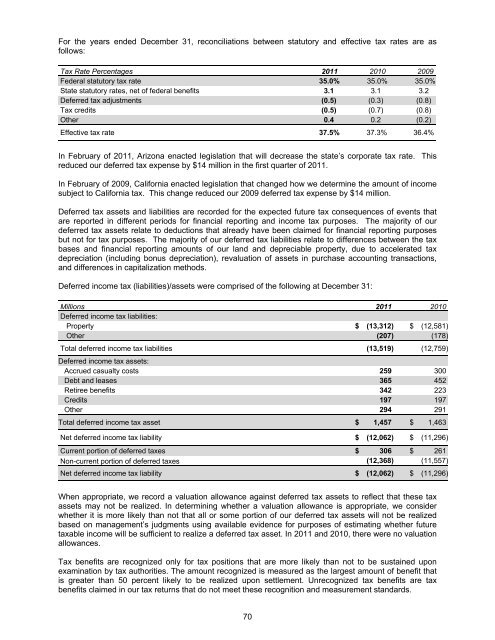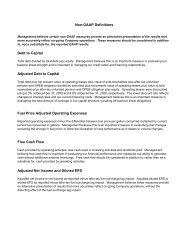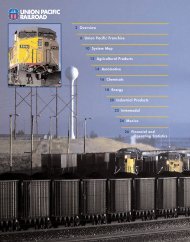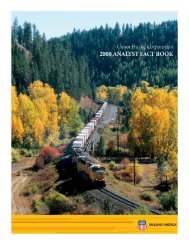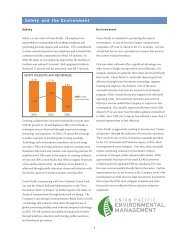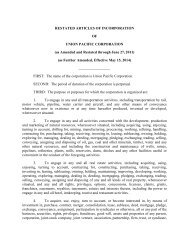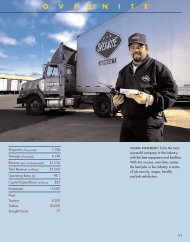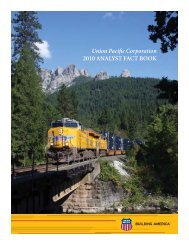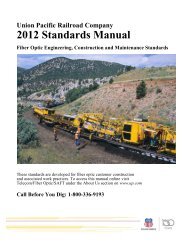Form 10-K - Union Pacific
Form 10-K - Union Pacific
Form 10-K - Union Pacific
Create successful ePaper yourself
Turn your PDF publications into a flip-book with our unique Google optimized e-Paper software.
For the years ended December 31, reconciliations between statutory and effective tax rates are as<br />
follows:<br />
Tax Rate Percentages 2011 20<strong>10</strong> 2009<br />
Federal statutory tax rate 35.0% 35.0% 35.0%<br />
State statutory rates, net of federal benefits 3.1 3.1 3.2<br />
Deferred tax adjustments (0.5) (0.3) (0.8)<br />
Tax credits (0.5) (0.7) (0.8)<br />
Other 0.4 0.2 (0.2)<br />
Effective tax rate 37.5% 37.3% 36.4%<br />
In February of 2011, Arizona enacted legislation that will decrease the state’s corporate tax rate. This<br />
reduced our deferred tax expense by $14 million in the first quarter of 2011.<br />
In February of 2009, California enacted legislation that changed how we determine the amount of income<br />
subject to California tax. This change reduced our 2009 deferred tax expense by $14 million.<br />
Deferred tax assets and liabilities are recorded for the expected future tax consequences of events that<br />
are reported in different periods for financial reporting and income tax purposes. The majority of our<br />
deferred tax assets relate to deductions that already have been claimed for financial reporting purposes<br />
but not for tax purposes. The majority of our deferred tax liabilities relate to differences between the tax<br />
bases and financial reporting amounts of our land and depreciable property, due to accelerated tax<br />
depreciation (including bonus depreciation), revaluation of assets in purchase accounting transactions,<br />
and differences in capitalization methods.<br />
Deferred income tax (liabilities)/assets were comprised of the following at December 31:<br />
Millions 2011 20<strong>10</strong><br />
Deferred income tax liabilities:<br />
Property $ (13,312) $ (12,581)<br />
Other (207) (178)<br />
Total deferred income tax liabilities (13,519) (12,759)<br />
Deferred income tax assets:<br />
Accrued casualty costs 259 300<br />
Debt and leases 365 452<br />
Retiree benefits 342 223<br />
Credits 197 197<br />
Other 294 291<br />
Total deferred income tax asset $ 1,457 $ 1,463<br />
Net deferred income tax liability $ (12,062) $ (11,296)<br />
Current portion of deferred taxes $ 306 $ 261<br />
Non-current portion of deferred taxes (12,368) (11,557)<br />
Net deferred income tax liability $ (12,062) $ (11,296)<br />
When appropriate, we record a valuation allowance against deferred tax assets to reflect that these tax<br />
assets may not be realized. In determining whether a valuation allowance is appropriate, we consider<br />
whether it is more likely than not that all or some portion of our deferred tax assets will not be realized<br />
based on management’s judgments using available evidence for purposes of estimating whether future<br />
taxable income will be sufficient to realize a deferred tax asset. In 2011 and 20<strong>10</strong>, there were no valuation<br />
allowances.<br />
Tax benefits are recognized only for tax positions that are more likely than not to be sustained upon<br />
examination by tax authorities. The amount recognized is measured as the largest amount of benefit that<br />
is greater than 50 percent likely to be realized upon settlement. Unrecognized tax benefits are tax<br />
benefits claimed in our tax returns that do not meet these recognition and measurement standards.<br />
70


